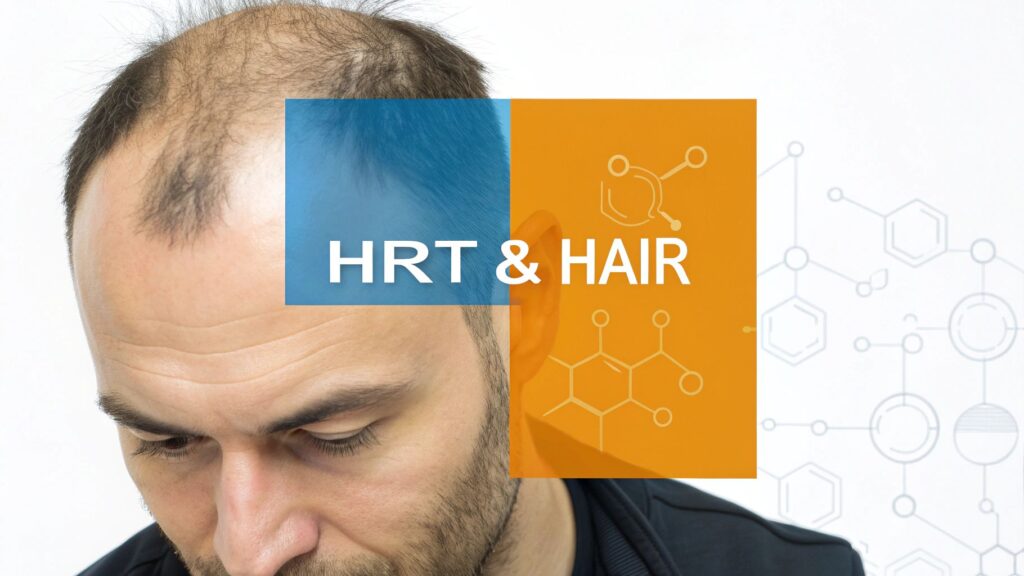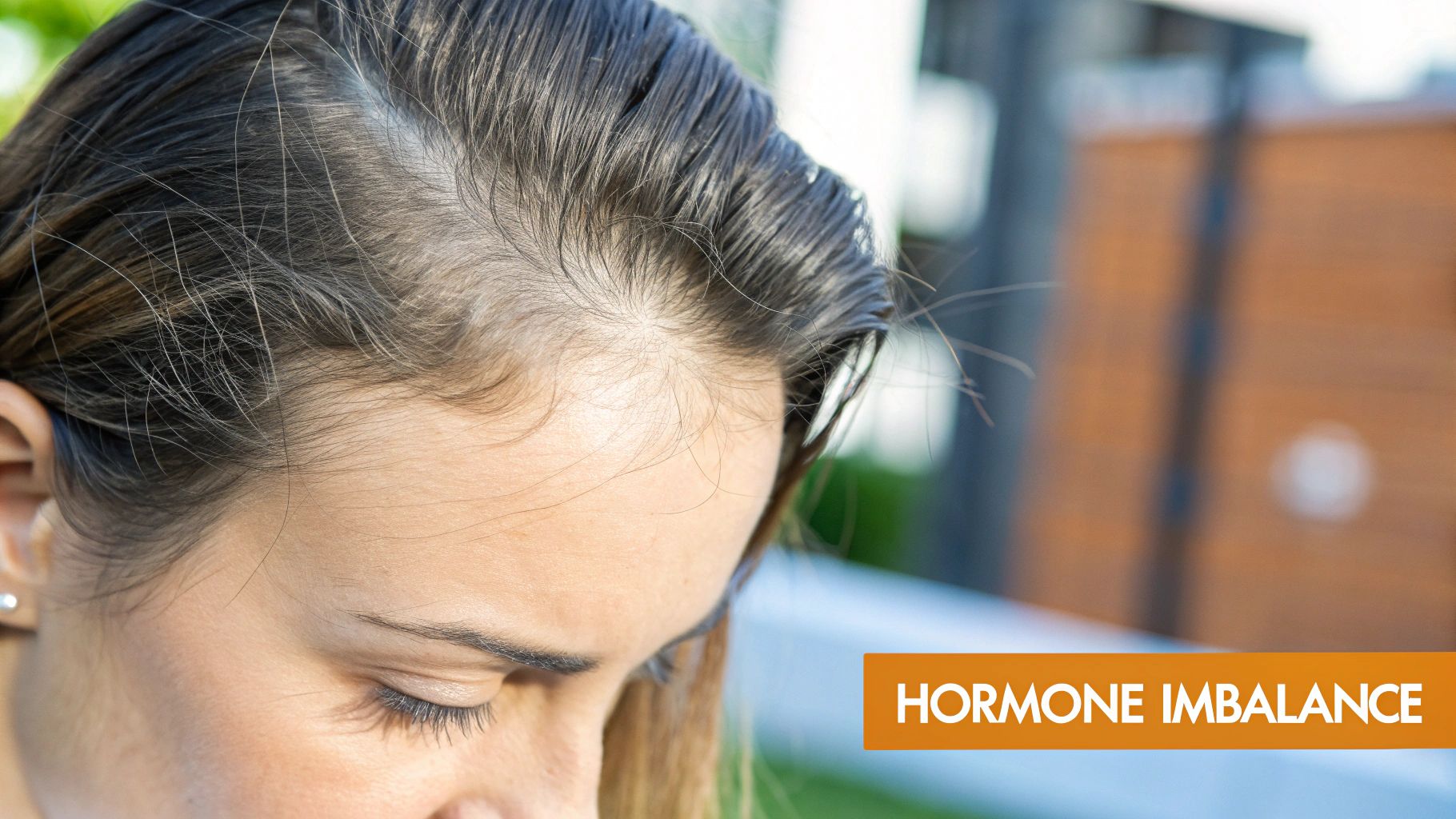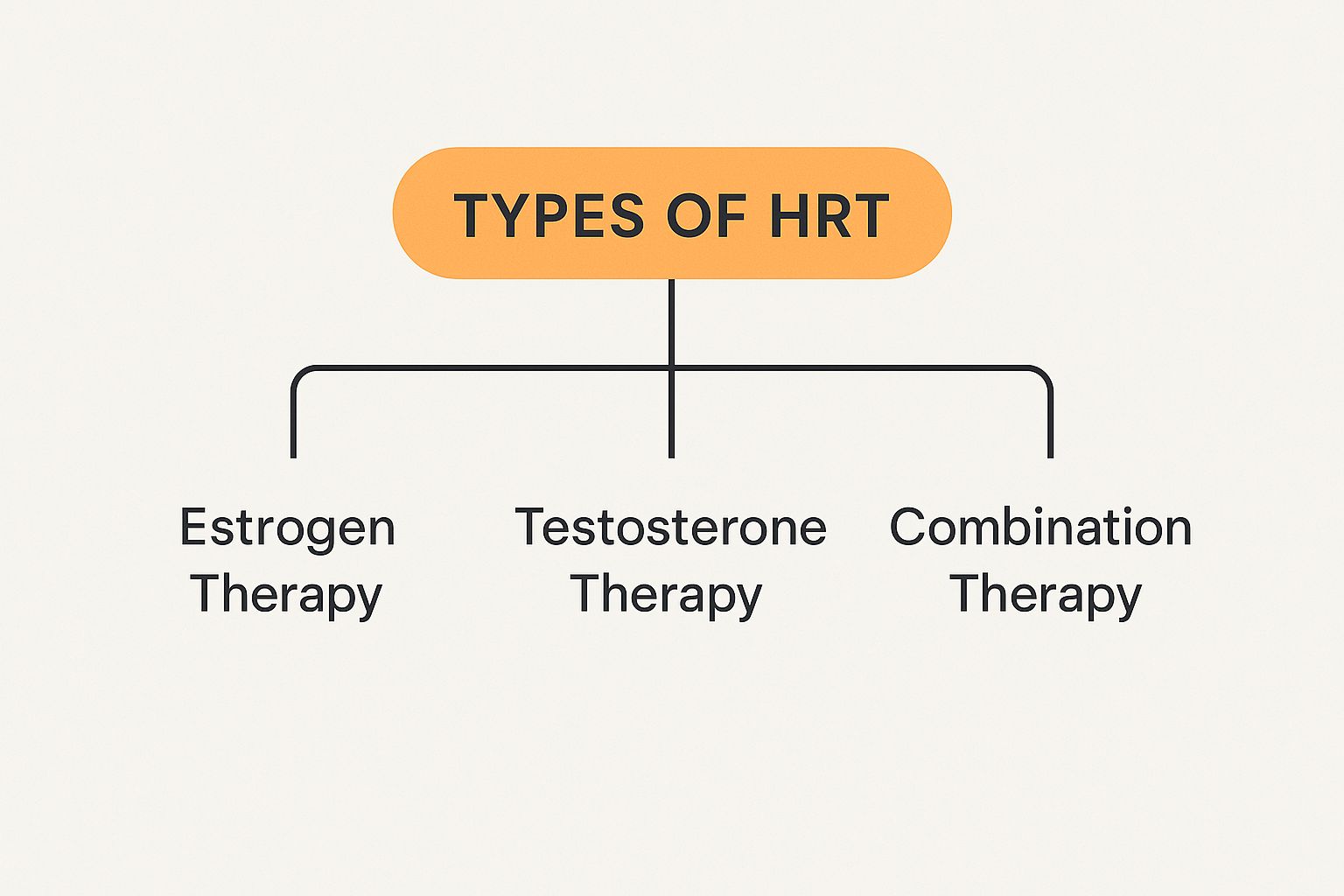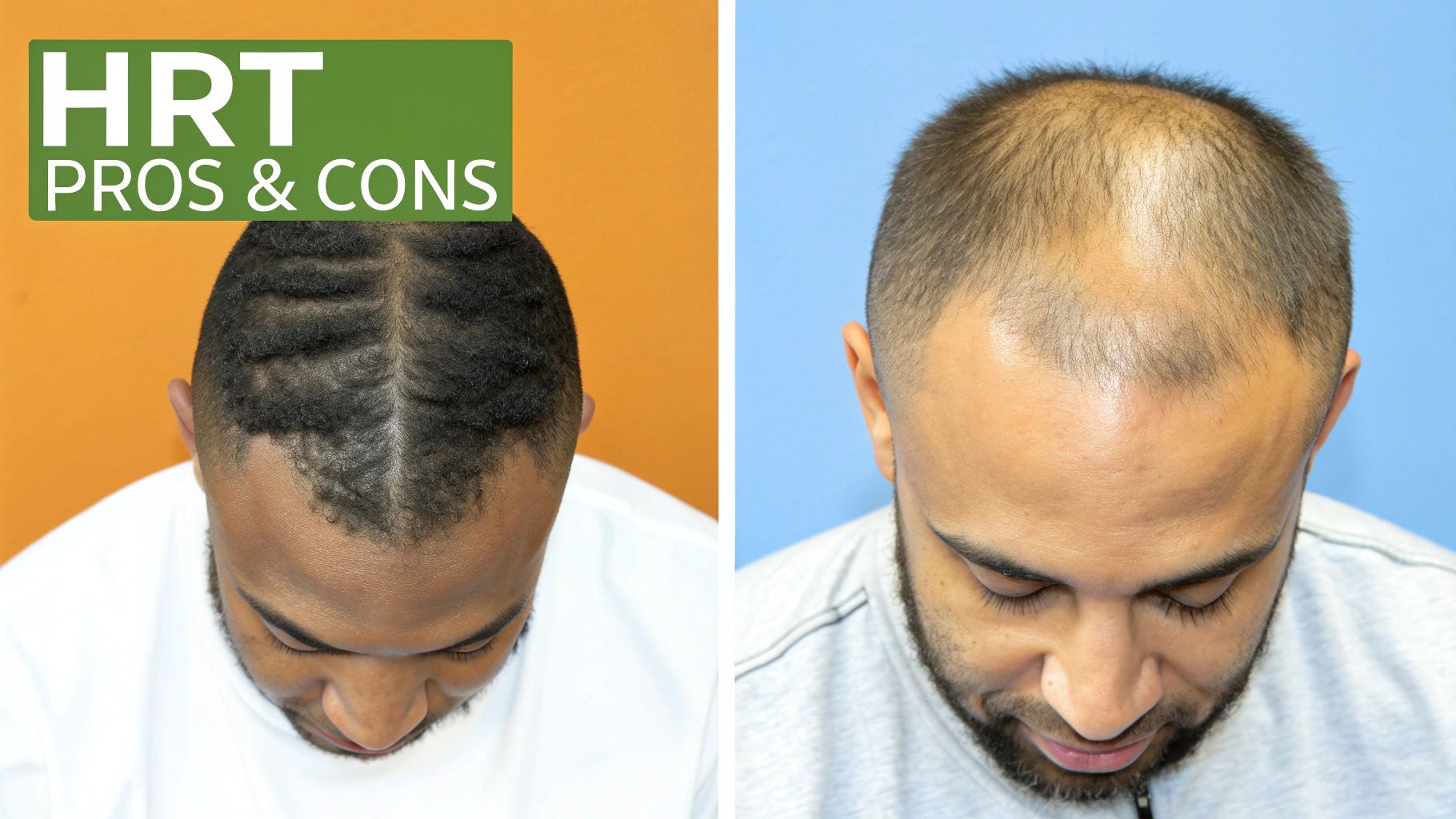Hormone Replacement and Hair Loss Explained

The connection between hormone replacement and hair loss is a tricky one, and it's deeply personal. For some people, hormone replacement therapy (HRT) can feel like a miracle, bringing back the thickness and life to their hair. For others, it can be the unexpected trigger for shedding. What makes the difference? It all comes down to the specific hormones being used, your own genetic wiring, and how your body decides to react to the change.
The Hormone and Hair Connection

Before we can untangle the HRT and hair loss puzzle, we need a quick refresher on how hair grows in the first place. Think of your hair follicles as tiny, dedicated factories that run on a very strict schedule, broken down into three phases.
- Anagen (The Growth Phase): This is the main event, the active manufacturing stage where your hair is growing longer. This phase can last anywhere from two to seven years.
- Catagen (The Transition Phase): A very brief intermission, lasting just a few weeks. The follicle shrinks, cuts itself off from the blood supply, and stops growing.
- Telogen (The Resting Phase): The follicle basically takes a three-month vacation. At the end of this phase, the old hair is shed, making room for a new one to start the cycle all over again.
Hormones are the managers running this entire operation. They’re the ones on the factory floor, telling each follicle when to kick into high gear, when to take a break, and when to let go. The three most influential managers in this process are estrogen, progesterone, and androgens like testosterone.
The Role of Key Hormones
Estrogen is often called the "hair-friendly" hormone, and for good reason. It helps keep hair in the anagen (growth) phase for longer. When estrogen levels are high, more follicles are in that active growth stage at any given time, which translates to thicker, fuller hair.
Progesterone also plays a key supportive role. It helps to balance out the effects of androgens, which can try to shorten that all-important growth cycle.
But when it comes to hair loss, androgens are the real troublemakers. Specifically, a powerful byproduct of testosterone called dihydrotestosterone (DHT) is the primary culprit. DHT can latch onto receptors in hair follicles, causing them to shrink in a process called miniaturization. Over time, these shrunken follicles produce finer and shorter hairs until they eventually stop producing hair at all.
This delicate hormonal balance is everything. During menopause, for example, estrogen and progesterone levels take a nosedive. This leaves androgens with more influence than they should have, shortening the growth phase and speeding up that follicle-shrinking process. This is what leads to the diffuse thinning so many women experience.
To help you keep these players straight, here’s a quick summary of how they impact your hair.
A Quick Look at Hormones and Your Hair
This table simplifies the roles of the main hormones and how HRT can shift their balance, for better or for worse.
| Hormone | Primary Role in Hair Health | Effect of Imbalance |
|---|---|---|
| Estrogen | Extends the anagen (growth) phase, promoting thicker hair. | Low levels can shorten the growth cycle, leading to thinning. |
| Progesterone | Helps counteract the hair-thinning effects of androgens. | Low levels give androgens more influence over follicles. |
| Androgens (Testosterone/DHT) | Can shrink hair follicles, leading to hormonal hair loss (miniaturization). | High or unopposed levels are a primary driver of androgenetic alopecia. |
The goal of HRT is to restore this balance, but as you’ll see, the type of hormone used makes all the difference. To get a better handle on the basics, you can learn more about what hormone replacement therapy is and how it’s designed to work.
How Different Types of HRT Affect Your Hair
Stepping into the world of hormone replacement therapy can feel like trying to learn a new language, especially when your hair's health is a top concern. "HRT" isn't a single treatment; it's a broad umbrella covering different hormonal cocktails and delivery methods. Each one can have a totally different impact on your hair follicles.
Figuring out these differences is the first step toward a treatment plan that helps you feel your best and supports your hair goals.
The type of hormone used is probably the biggest piece of the puzzle. HRT can be made with bioidentical hormones, which are exact molecular copies of what your body produces, or synthetic hormones, which are chemically tweaked. This isn't just a minor detail—it can completely change how your body, and especially your hair, responds to therapy.
The infographic below gives a quick overview of the main categories of hormone replacement therapy.

As you can see, HRT is a spectrum of options, from estrogen-only to various combination therapies, and each one needs to be considered carefully.
Estrogen Therapy: The Hair Protector
When it comes to hair, estrogen is definitely the good guy. It's widely considered a "hair-friendly" hormone. Therapies that are rich in estrogen, especially estradiol, work by making the anagen (growth) phase of the hair cycle last longer.
Think of it like giving your hair follicles a longer, more productive work shift. This extended growth period means more hairs are on your head at any given time, creating a fuller, healthier look.
For many women dealing with menopausal hair thinning, reintroducing estrogen can be a total game-changer. It helps push back against the growing influence of androgens like DHT, the main culprits behind shrinking hair follicles. Taking the time to explore different estrogen replacement therapy options can help you figure out which form is the best fit for your specific needs.
The Progestin Problem: Androgenic Effects
While estrogen often plays the hero, the type of progestin it’s paired with in combination therapy can sometimes be the villain. Progestin is the synthetic version of progesterone, and some of the older, synthetic types have what’s known as an androgenic effect.
In simple terms, this means they can act like male hormones (think testosterone) once they’re in your body.
This is a critical piece of the hormone replacement and hair loss puzzle. If you have a genetic tendency for androgenetic alopecia (female pattern hair loss), using an HRT with a high-androgenic progestin can actually speed up thinning. It’s like accidentally pouring gasoline on the fire you're trying to put out.
Key Takeaway: The specific progestin in your HRT formula matters—a lot. Not all progestins are the same, and choosing one with little to no androgenic activity is key to protecting your hair.
Bioidentical vs. Synthetic Hormones
This brings us to the crucial difference between bioidentical and synthetic hormones. Bioidentical progesterone is chemically identical to what your body makes naturally and doesn't have the androgenic side effects tied to some synthetic progestins. For this reason, many doctors who specialize in hair health lean toward bioidentical HRT formulas.
When you talk to your doctor, it's vital to ask about the specific type of progestin being recommended. Here’s a quick breakdown:
- Higher Androgenic Activity: Levonorgestrel, norethindrone
- Lower Androgenic Activity: Drospirenone, norgestimate
- No Androgenic Activity: Bioidentical progesterone
The relationship between hormones and hair is complex, but the right therapy can make a huge difference. For example, research shows that 62% of premenopausal women with female pattern hair loss saw noticeable improvements when they took a medication like finasteride along with oral contraceptives. This shows just how powerful it is to target the right hormonal pathways, making the choice of HRT type a critical decision in your treatment journey.
Why HRT Can Sometimes Trigger Hair Thinning

It seems completely backward—starting a therapy meant to restore balance, only to find it causing the very issue you hoped to avoid. Yet, the link between hormone replacement and hair loss isn't always straightforward. Sometimes, that initial adjustment period can be confusing and frankly, pretty stressful.
If you’ve noticed more hair in your brush after starting HRT, you're not imagining things. This paradoxical reaction usually boils down to two main culprits: your body's initial shock to the hormonal shift and the specific type of hormone used in your therapy.
Getting to the bottom of why this happens is the first step. It's the key to navigating it successfully and finding a path that supports both your overall well-being and your hair health.
The Initial Shock and Telogen Effluvium
Any big change to your body's internal chemistry—whether from stress, illness, or a new medication—can throw your hair's finely tuned growth cycle out of whack. Starting HRT is a major hormonal shift, and it can sometimes send a signal to your hair follicles to jump into the resting (telogen) phase all at once.
This condition is known as telogen effluvium, a temporary but dramatic form of hair shedding that typically shows up a few months after a triggering event. Think of it like transplanting a delicate plant; it goes through an initial shock where it might drop a few leaves before it can establish new roots and start to thrive again.
This diagram shows how the hair growth cycle can be disrupted, leading to a sudden increase in hairs entering the shedding phase.
The good news? This kind of shedding is almost always temporary. As your body adapts to its new hormonal baseline over three to six months, the hair cycle gets back to normal, and the excessive shedding should stop.
The Problem with Progestin Androgenicity
Beyond the initial adjustment, a more persistent cause of hair thinning on HRT can be traced to the specific type of progestin used, especially in combination therapies. Progestins are synthetic versions of progesterone, and some of them have what’s known as a high androgenic index.
In simple terms, this means they can act like androgens (male hormones like testosterone) in the body. When these progestins bind to androgen receptors on your scalp, they can trigger the exact same follicle miniaturization process seen in genetic hair loss, causing follicles to shrink and produce finer, weaker strands.
For anyone with a genetic predisposition to hormonal hair loss, choosing an HRT with a high-androgenic progestin can unfortunately be like adding fuel to a fire you were hoping to put out.
This is a critical detail to discuss with your healthcare provider. Opting for bioidentical progesterone or a synthetic progestin with low androgenic activity can make a huge difference in protecting your hair.
Genetic Sensitivity to DHT
Ultimately, your own genetics play the starring role in how your hair follicles respond to any hormonal changes. Some of us are just more sensitive to dihydrotestosterone (DHT), the potent androgen that is the primary driver of genetic hair loss in both men and women.
Testosterone converts to DHT through an enzyme called 5-alpha reductase. Certain HRT formulations, particularly testosterone replacement therapy (TRT), can increase your overall testosterone levels, leading to more DHT. For those of us predisposed to hair loss, even a small increase can be enough to kickstart thinning. If you want to dive deeper into this specific mechanism, you might find our guide that explores if taking testosterone causes hair loss and the science behind it really helpful.
The interplay between your HRT protocol and your genetic wiring is what determines the final outcome. A therapy that works perfectly for one person might cause issues for another, which is exactly why a personalized approach is non-negotiable when it comes to managing hormone replacement.
So, Can HRT Actually Help With Hair Loss?

While the fear of making hair loss worse is a valid concern when considering hormone replacement, it's time to look at this from a different angle. For many women, HRT isn't the problem—it's actually the most direct solution, especially when thinning hair is a direct result of the hormonal rollercoaster of menopause.
As estrogen and progesterone levels drop off with age, the hair's active growing phase (anagen) gets shorter. At the same time, the resting and shedding phase (telogen) lasts longer. This imbalance is exactly what leads to more hair in your brush, less active growth, and that diffuse thinning so many women notice.
This is precisely where a properly managed HRT plan can make a powerful difference. By strategically reintroducing the hormones your body is missing, you can directly fight back against these age-related changes happening at the follicle level.
How Estrogen Brings Your Follicles Back to Life
Think of estrogen as a protective force for your hair. Its biggest benefit is its ability to lengthen the anagen, or growth, phase of the hair cycle. When your estrogen levels are brought back into a healthy range, your hair follicles get a clear signal to stay in their active growth state for longer.
This one simple change creates a domino effect of positive results:
- Better Hair Density: With more follicles actively producing hair at any given time, the overall fullness of your hair can improve noticeably.
- Less Shedding: By keeping hair in the growth phase longer, estrogen delays its entry into the shedding phase. That means less hair in the shower drain.
- A Shield Against Androgens: Balanced estrogen levels help protect your follicles from the shrinking effect of DHT, the potent androgen that causes so much trouble for hair.
By restoring this vital hormone, HRT can effectively turn back the clock for your hair, creating a healthier internal environment where follicles can thrive instead of shrink away.
A clinical pilot study of women aged 47 to 56 showed that adding estradiol (E2) during HRT successfully cut down on hair loss by reducing the percentage of hairs in the shedding phase. In fact, 11 out of 13 participants reported that their hair loss improved, showing how restoring female hormones can directly combat thinning. You can find more details in this Japanese hair loss study on ncbi.nlm.nih.gov.
The Journey Back to Fuller Hair
To see what this looks like in the real world, let's talk about Sarah, a 52-year-old who started to notice her part widening and her ponytail feeling alarmingly thin. The emotional toll was huge, chipping away at her confidence every single day. After seeing a specialist, she learned her hair loss was a classic symptom of the hormonal shifts of menopause.
She was hesitant to start HRT, worried it might just make things worse. But her doctor walked her through the science, designing a bioidentical hormone plan that was rich in hair-friendly estradiol and balanced with natural progesterone.
The first few months took patience as her body adjusted. But around the six-month mark, the excessive shedding started to slow down dramatically. By her one-year appointment, she could see fine, new hairs sprouting along her hairline. Her hair felt stronger, and the volume was starting to come back. For Sarah, the right hormone replacement and hair loss plan wasn't a risk—it was the path back to feeling like herself again.
Her story gets to a critical point: when hair loss is driven by a hormone deficiency, restoring those hormones is often the most effective way to treat it. It gets to the root cause from the inside out, instead of just trying to manage the symptoms from the outside.
Proactive Strategies to Protect Your Hair on HRT
Taking control of your hair's health while on hormone replacement therapy isn't about luck; it's about having the right action plan. Instead of waiting and reacting to changes, you can put practical, evidence-based strategies in place from day one. This proactive approach means working closely with your doctor, making smart lifestyle choices, and considering supportive treatments to build a comprehensive defense for your hair.
The goal is simple: create an internal and external environment where your hair follicles can thrive, even as your body adjusts to its new hormonal balance.
Finding a Hair-Friendly HRT Regimen With Your Doctor
Your most important ally in this journey is your healthcare provider. Being open about your concerns regarding the connection between hormone replacement and hair loss isn't just helpful—it's absolutely essential. Before you even start treatment, make it clear that protecting your hair is a top priority for you.
This single conversation can shape the entire direction of your therapy. Your doctor can help you navigate the options to find a more hair-friendly HRT formulation. For instance, they might suggest:
- Bioidentical Progesterone: Unlike some synthetic progestins that have androgenic (testosterone-like) effects, bioidentical progesterone doesn't carry the same risk of triggering follicle miniaturization.
- Low-Androgenic Progestins: If a synthetic option is the best choice for you, certain types like drospirenone have much lower androgenic activity compared to older, more traditional formulations.
- Transdermal vs. Oral Routes: Some evidence suggests that how you take your hormones matters. Transdermal applications like patches or gels may lead to different DHT conversion rates than oral pills or injections, which could be a deciding factor in your treatment plan.
By talking through these specifics, you and your doctor can land on a therapy that meets both your hormonal needs and your hair health goals.
The Critical Role of Hormone Monitoring
Once you begin HRT, the work isn't over—it’s just getting started. Regular monitoring of your hormone levels is non-negotiable for making sure your treatment is both safe and effective. Think of it like tuning a musical instrument; small, precise adjustments are needed to keep everything in perfect harmony.
Consistent blood tests give your doctor a clear picture of exactly how your body is responding to the therapy. They can track key markers like estradiol, progesterone, testosterone, and most importantly, DHT.
If your DHT levels start to creep up, it’s an early warning sign that your current protocol might be contributing to hair thinning. This data gives your doctor the power to make informed tweaks to your dosage or formulation before significant hair loss can happen.
This feedback loop is your best defense against unwanted side effects. It turns your treatment from a static prescription into a dynamic, responsive plan tailored to your body's unique chemistry.
Supportive Lifestyle and Nutrition Adjustments
While HRT works on your hormones from the inside, your lifestyle choices provide the essential building blocks your hair needs to grow strong. Nutrition plays a starring role here. Deficiencies in key vitamins and minerals can easily mimic or worsen hormonal hair loss.
Make a point to get enough of these crucial nutrients:
- Iron: This is vital for producing hemoglobin, which carries oxygen to all your cells, including your hair follicles. Low ferritin (your body's stored iron) is a well-known culprit behind shedding.
- Zinc: An essential mineral for hair tissue growth and repair. It also helps keep the oil glands around the follicles working as they should.
- Biotin and B Vitamins: These are fundamental for producing keratin, the very protein that makes up your hair strands.
Beyond what's on your plate, managing stress is paramount. High cortisol levels from chronic stress can push more hair follicles into the shedding phase of the growth cycle. Simple practices like meditation, yoga, or even a regular walk can help lower cortisol and support healthy hair growth.
To give your hair a fighting chance, many people find success by combining their internal efforts with external support. This is where different hair loss management strategies come into play, each with its own way of working.
The table below gives you a quick overview of some popular approaches, how they work, and who they might be best for.
Comparing Hair Loss Management Strategies on HRT
| Strategy | How It Works | Best For |
|---|---|---|
| Topical Minoxidil (Rogaine) | Works as a vasodilator, increasing blood flow to follicles and extending the hair's growth phase (anagen). | Individuals noticing general thinning or a widening part. It stimulates existing follicles but doesn't block DHT. |
| Low-Level Laser Therapy (LLLT) | Uses red light energy to stimulate cellular activity within the follicles, encouraging them to enter and remain in the growth phase. | Those with early-stage hair loss or thinning who want a non-invasive, drug-free option to support hair density. |
| Platelet-Rich Plasma (PRP) | Involves injecting a concentration of your own blood platelets into the scalp. These platelets release growth factors that stimulate follicle activity and repair. | People looking for a natural approach to stimulate dormant follicles and improve the health and thickness of existing hair. |
| DHT-Blocking Shampoos | Contain ingredients like ketoconazole, saw palmetto, or caffeine, which are thought to reduce DHT's effects on the scalp follicles. | Anyone on HRT as a supportive, preventative measure to complement their primary treatment and maintain a healthy scalp environment. |
These strategies aren't mutually exclusive. In fact, they often work best when used together. For example, using a DHT-blocking shampoo while also applying minoxidil can create a powerful one-two punch that protects and stimulates your follicles, giving you the best possible outcome on your HRT journey.
Your Questions About HRT and Hair, Answered
Even when you understand the science, you're bound to have specific questions about what to expect on your own journey. The link between hormone replacement and hair loss is personal, and getting clear answers to common worries can bring some much-needed peace of mind. Let’s tackle the most frequent questions with direct, practical answers.
How Long Does Hair Loss From HRT Last?
If you notice more shedding right after starting HRT, it's often a temporary phase called telogen effluvium. This is just your body’s initial reaction to a major hormonal shift, and it usually settles down within three to six months as your system gets used to the new balance.
However, if the thinning continues past this adjustment period, that could be a sign that your HRT formula isn’t the best match for you. Persistent shedding might suggest the type of progestin has androgenic effects, which is a clear signal to talk to your doctor. They might need to adjust your dose or switch you to a more hair-friendly option.
Will Stopping HRT Make My Hair Fall Out?
Yes, stopping HRT can trigger another round of shedding. The reason is the same as when you start it—it's another big hormonal change. Your hair follicles get accustomed to the supportive environment created by steady estrogen levels, and a sudden drop can shock the growth cycle, pushing more hair into the shedding phase too soon.
This can be especially noticeable if you were using HRT to combat menopausal hair thinning in the first place.
Important Note: Always talk to your doctor before stopping HRT. They can help you taper off your dosage slowly, which can minimize side effects like another bout of temporary hair loss.
Can I Use Minoxidil While on HRT?
Absolutely. Using a topical treatment like minoxidil (you probably know it as Rogaine) alongside your HRT is generally safe and can be a very effective strategy. Think of it as a one-two punch for supporting your hair health.
- HRT works from the inside: It gets to the root of the problem by addressing the hormonal imbalances that cause thinning.
- Minoxidil works from the outside: It directly stimulates the hair follicles on your scalp, boosting blood flow and helping them stay in their growth phase longer.
This combination can create a powerful synergy for hair regrowth by tackling the issue from both angles. As with any new treatment, it's always a good idea to check with your doctor before adding minoxidil to your routine to make sure it fits with your overall health plan.
At Elite Bioscience, we provide tailored therapies to help you achieve your health and wellness goals with confidence. Discover how our customized treatment plans can support your journey by visiting https://elitebioscience.co.
QUICK SEARCH
Make an account today to start your journey towards a better and healthier lifestyle.






